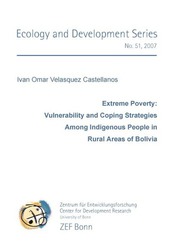| Fachbereiche | |
|---|---|
| Buchreihen (96) |
1378
|
| Nachhaltigkeit |
3
|
| Gesundheitswesen |
1
|
| Geisteswissenschaften |
2364
|
| Medienwissenschaften | 16 |
| Theologie | 57 |
| Philosophie | 102 |
| Rechtswissenschaft | 422 |
| Wirtschaftswissenschaften | 850 |
| Sozialwissenschaften | 416 |
| Sportwissenschaften | 48 |
| Psychologie | 233 |
| Pädagogik | 190 |
| Geschichtswissenschaften | 182 |
| Kunstwissenschaften | 111 |
| Kulturwissenschaften | 166 |
| Literaturwissenschaften | 116 |
| Sprachwissenschaften | 88 |
| Naturwissenschaften |
5406
|
| Ingenieurwissenschaften |
1793
|
| Allgemein |
98
|
|
Leitlinien Unfallchirurgie
5. Auflage bestellen |
|
Erweiterte Suche
Extreme Poverty: Vulnerability and Coping Strategies Among Indigenous People in Rural Areas of Bolivia
Ivan Velasquez (Autor)Vorschau
Inhaltsverzeichnis, Datei (71 KB)
Leseprobe, Datei (93 KB)
Indigenous people in Bolivia represent a majority of Bolivia’s population. In rural areas, most of the people speak their indigenous languages. Bolivia’s Quechuas and Aymaras, the two main indigenous groups, reside predominantly in the highlands and the valleys. Poverty is directly associated with deprivation of essential assets and is more common among the indigenous population with low levels of education. Rural areas are considered less favoured areas, where the poor are generally agricultural peasants or wage-earners with limited landholdings and lack of access to credit and basic infrastructure.
The study investigates the characteristics and determinants of extreme poverty, vulnerability and coping strategies among indigenous peoples in rural Bolivia using econometric techniques and conducting an empirical multivariate analysis of household welfare. The primary data source for this study is based on panel data set collected in 2004 and 2005 in rural areas of La Paz, Oruro, Potosi and Chuquisaca departments. The survey covers 822 households in each round. Specific communities in rural areas in Bolivia were identified for a household survey in order to obtain community perceptions on poverty, vulnerability, covariate shocks and coping mechanisms. I used a quantitative data set derived from a household survey in 2004 and 2005 to develop indices of poverty, inequality and chronic poverty, and econometric techniques to explore linkages between welfare, chronic poverty, vulnerability and coping strategies at the household and community levels in the four rural regions.
| ISBN-13 (Printausgabe) | 3867274436 |
| ISBN-13 (Printausgabe) | 9783867274432 |
| ISBN-13 (E-Book) | 9783736924437 |
| Buchendformat | A5 |
| Sprache | Englisch |
| Seitenanzahl | 260 |
| Umschlagkaschierung | glänzend |
| Auflage | 1 |
| Band | 0 |
| Erscheinungsort | Göttingen |
| Promotionsort | Göttingen |
| Erscheinungsdatum | 12.12.2007 |
| Allgemeine Einordnung | Dissertation |
| Fachbereiche |
Wirtschaftswissenschaften
|
| Schlagwörter | Bolivien, indigene Bevölkerung, extreme Armut, chronische Armut, Ungleichheit, Anfälligkeit, Bewältigungsstrategien. |








